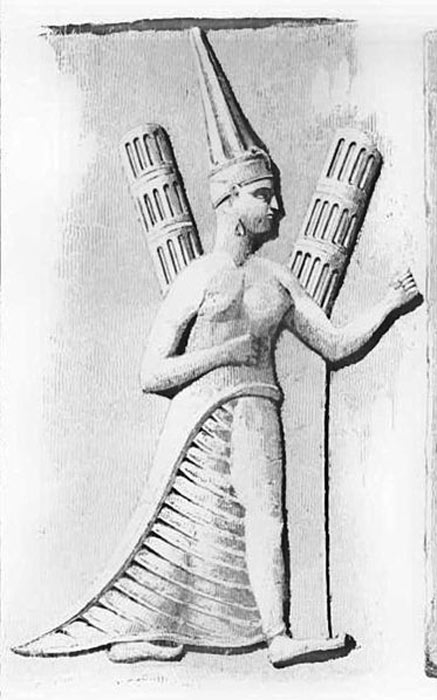
Farmer Finds 3,300-year-old Rare Hittite Bracelet in Field in Turkey!
While plowing his field, a farmer in Turkey’s central Çorum province came across something highly unusual. The plow of the farmer, from Çitli village in the Mecitözü district, had struck a bracelet that looked beautiful, old and precious. Realizing that it could have historical value, he took it to the Çorum Museum. Experts at the museum discovered that it was a rare Hittite bracelet from the late Bronze Age in Anatolian Turkey, reports the Daily Sabah.
“After initial evaluations, we realized that this piece is unprecedented and we’ve never seen anything like this before,” said Resul Ibiş, an archaeologist at the museum, to the Ihlas News Agency (IHA), according to the Daily Sabah.
The museum cleaned and restored the rare Hittite bracelet, which was deformed and had some parts missing when it was brought to them. After dating the Hittite bracelet to the 13th century BC, which is end of the Bronze Age, the bracelet was recorded in the museum’s inventory and added to its collection.
Resul Ibiş also told the IHA that very few pieces of Hittite jewelry are extant, and this extremely rare find will help throw light on styles of adornment in the Hittite civilization, which reached its height during the mid-14th century BC, covering an area that included most of Anatolia as well as parts of the northern Levant and Upper Mesopotamia.
Made of bronze, nickel, silver, and gold, the stunning 3,300-year-old artifact is decorated with Hittite symbols. The electrum alloy interior is covered with a thin plate of etched gold. According to Arkeonews, the gold plate has depictions of the Hurrian goddess Shaushka and her servants Ninatta and Kulitta.

Šauška, the primary Hurrian goddess of love and war, was also revered by the Hittites and for this reason she is depicted on the recently discovered rare Late Bronze Age Hittite bracelet. (Charles Texier / Public domain)
Why A Hurrian Goddess was on the Farmer’s Hittite Bracelet
The Hurrians were an influential part of the Hittite empire. They were a distinct Near Eastern peoples who spoke the Hurrian language. By the early Iron Age, they were completely assimilated within the larger Hittite population. The Hurrian religion had a powerful influence on Hittite beliefs as attested to by the fact that the farmer’s rare Hittite bracelet depicted the Hurrian goddess of love and war.
- The Rediscovery of Urkesh: Forgotten City of the Hurrians
- Love is a Battlefield: The Legend of Ishtar, First Goddess of Love and War
Šauška was the most important Hurrian goddess and was associated with love and war. She has been identified as the Hurrian equivalent of Mesopotamian goddess Ishtar. Šauška was also the goddess of incantations and was invoked to heal people and restore them to health. Although usually worshipped in feminine form and referred to with feminine titles like “allai,” which is Hurrian for lady, there are also references to a male avatar. Ninatta and Kulitta were two goddesses who waited upon Šauška and are also depicted on the farmer’s rare Hittite bracelet.

The Lion Gate in the southwest part of the UNESCO Hattusa ruins, which are now a giant open-air archaeological park and one of Turkey's most important tourist destinations. (Bernard Gagnon / CC BY-SA 3.0)
The Hittites and Hattusa, the "Memory of the World"
The Hittites were an ancient Anatolian people who established an empire at Hattusa in north-central Anatolia around 1600 BC. It reached its height during the mid-14th century BC. The Hittite civilization played an important role in the development of urban life in the Late Bronze Age. Credited with the making of the first iron weapons and armor, the Hittites lived through the transition from the Bronze Age to the Iron Age.
Today, Hattusa, which was the first national excavation site in Turkey, is one of the country’s most visited tourist destinations. With its well-preserved ancient buildings and archaeological sites, it was added to the UNESCO World Heritage list in 1986. It serves as an open-air museum enclosed by a 6-kilometer (4-mile) wall that contains massive gates, a 71-meter (78-yard) long underground passage, the Hittite palace in Büyükkale, 31 excavated temples, and ancient wheat silos.
With the thousands of cuneiform script tablets unearthed at Hattusa, it has also been awarded the UNESCO title of “Memory of the World” since 2001. In fact, the very first series of excavations at Hattusa, carried out from 1906 to 1912, unearthed 10,000 cuneiform script tablets. Work on these by archaeologist and linguist Bedřich Hrozný established that Hittite or Nesite was an Indo-European language.
- World’s Oldest Mosaic Unearthed in Turkey
- Deciphering Cuneiform to Get a Handle on Life in Ancient Mesopotamia
The cleaned and restored bracelet is now on display at the Çorum Museum. The ancient site of Hattusa has led to a rich haul for archaeologists. Its astonishingly well-preserved architectural wonders and its massive cache of cuneiform tablets have led to some ground-breaking discoveries, including the Indo-European identification of the Hittite language. However, few pieces of jewelry have been found belonging to the Hittite civilization. The recent find of the bracelet with its rich carvings will serve to fill a gap in the historical record.
Top image: This is the rare 3,300-year-old Hittite bracelet that a Turkish farmer found in his field, which he turned in to the proper authorities. Source: Anadolu Agency
By Sahir Pandey
References
Daily Sabah. 2022. Farmer discovers rare Hittite-era bracelet in Turkey's Çorum. Available at: https://www.dailysabah.com/life/history/farmer-discovers-rare-hittite-era-bracelet-in-turkeys-corum
Kayra, Oguz. 2022. Rare Hittite bracelet, 3300 years old, found by a farmer. Available at: https://arkeonews.net/rare-hittite-bracelet-3300-years-old-found-by-a-farmer/
Waters, Conny. 2022. Unique 3,300-Year-Old Hittite Bracelet with Symbols Discovered By Farmer. Available at: https://www.ancientpages.com/2022/03/28/unique-3300-year-old-hittite-bracelet-with-symbols-discovered-by-farmer/















